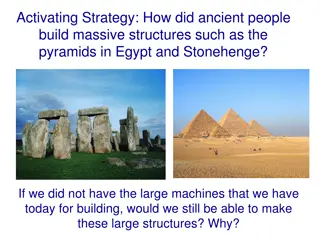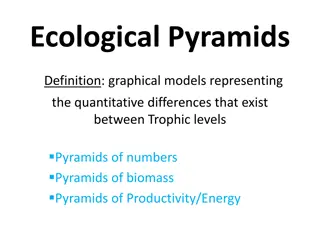A Comparison of Stonehenge and the Pyramids of Giza
The Egyptian pyramids, located in Egypt, were primarily built as tombs for pharaohs. Imhotep is credited with the method of stacking mastabas to create these impressive structures. Construction involved moving massive stone blocks using sleds and wetting sand to reduce friction. The pyramids were believed to serve as a gateway to the heavens for the pharaoh's soul. All pyramids were built on the west bank of the Nile, associated with the realm of the dead. Inside, burial chambers, ventilation shafts, and passageways were constructed for the pharaoh's burial.
Download Presentation

Please find below an Image/Link to download the presentation.
The content on the website is provided AS IS for your information and personal use only. It may not be sold, licensed, or shared on other websites without obtaining consent from the author.If you encounter any issues during the download, it is possible that the publisher has removed the file from their server.
You are allowed to download the files provided on this website for personal or commercial use, subject to the condition that they are used lawfully. All files are the property of their respective owners.
The content on the website is provided AS IS for your information and personal use only. It may not be sold, licensed, or shared on other websites without obtaining consent from the author.
E N D
Presentation Transcript
Tuesday 23rd February 2021 To compare the building of Stonehenge and the pyramids of Giza.
The Egyptian pyramids are ancient pyramid- shaped structures located in Egypt. There are currently over 100 pyramids in existence in Egypt, with the most famous pyramids being found at Giza which is just outside the capital city Cairo. Most pyramids were built as tombs for the country s pharaohs. The earliest known Egyptian pyramids were constructed 2630 BC 2611 BC.
Imhotep is credited with being the first to conceive the notion of stacking mastabas on top of each other, creating a large, imposing building composed of a number of "steps" that decreased in size towards its apex. These steps were designed to serve as a gigantic stairway by which the soul of the deceased pharaoh could ascend to the heavens.
Constructing the pyramids involved moving huge quantities of stone. The quarried blocks were likely transported to the construction site by wooden sleds, with sand in front of the sled wetted to reduce friction. Droplets of water created bridges between the grains of sand, helping them stick together.
The Egyptians believed the dark area of the night sky around which the stars appear to revolve was the physical gateway into the heavens. One of the narrow shafts that extend from the main burial chamber through the entire body of the Great Pyramid points directly towards the centre of this part of the sky. This suggests the pyramid may have been designed to serve as a means to magically launch the deceased pharaoh's soul directly into the abode of the gods.
All Egyptian pyramids were built on the west bank of the Nile, which, as the site of the setting sun, was associated with the realm of the dead in Egyptian mythology.
Inside the Pyramids, ancient Egyptians built a series of burial chambers, ventilation shafts and passageways. The Pharaoh's sarcophagus was placed in the king's burial chamber. The ancient Egyptians believed that a part of the Pharaoh's spirit remained with his body after death and so they buried with him anything that he might need in the afterlife including gold, favourite objects and pottery.
Tuesday 23rd February 2021 To compare the building of Stonehenge and the pyramids of Giza. 1. Explain how the pyramids were built (including some details of the design inside and outside). 2. Explain why the pyramids were built. 3. Which do you think was the greatest achievement and why Stonehenge or the Pyramids of Giza? Write a paragraph to explain your decision. I think ____________________ is the greater achievement because .























